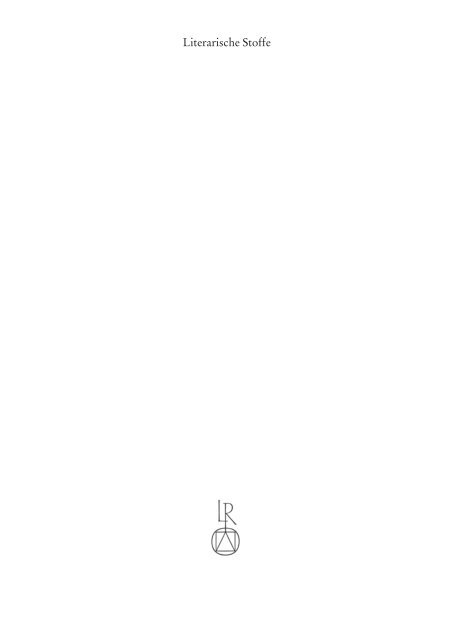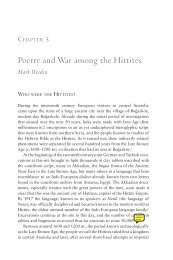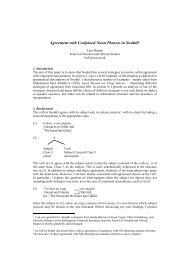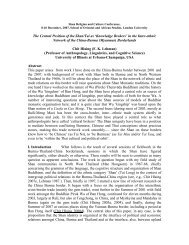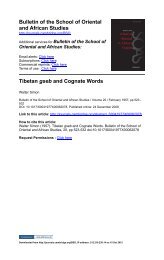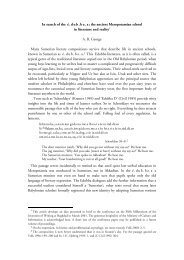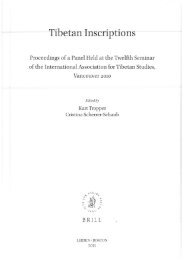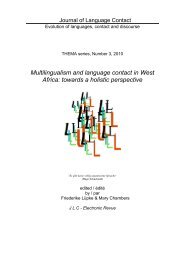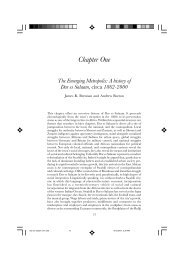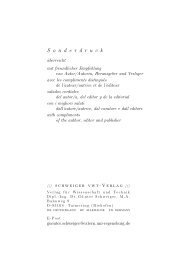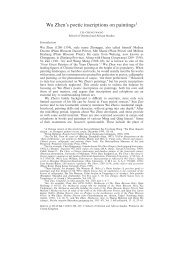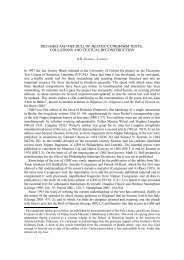Literarische Stoffe - The School of Oriental and African Studies
Literarische Stoffe - The School of Oriental and African Studies
Literarische Stoffe - The School of Oriental and African Studies
Create successful ePaper yourself
Turn your PDF publications into a flip-book with our unique Google optimized e-Paper software.
<strong>Literarische</strong> <strong>St<strong>of</strong>fe</strong>
BEITRÄGE ZUR IRANISTIK<br />
Gegründet von Georges Redard, herausgegeben von Nicholas Sims-Williams<br />
B<strong>and</strong> 31<br />
<strong>Literarische</strong> <strong>St<strong>of</strong>fe</strong> und ihre Gestaltung<br />
in mitteliranischer Zeit<br />
Herausgegeben<br />
von<br />
Desmond Durkin-Meisterernst,<br />
Christiane Reck und Dieter Weber<br />
WIESBADEN 2009<br />
DR. LUDWIG REICHERT VERLAG
<strong>Literarische</strong> <strong>St<strong>of</strong>fe</strong><br />
und ihre Gestaltung<br />
in mitteliranischer Zeit<br />
Kolloquium anlässlich des 70. Geburtstages<br />
von Werner Sundermann<br />
Herausgegeben<br />
von<br />
Desmond Durkin-Meisterernst,<br />
Christiane Reck und Dieter Weber<br />
WIESBADEN 2009<br />
DR. LUDWIG REICHERT VERLAG
Förderung der Tagung<br />
und die Drucklegung des Tagungsb<strong>and</strong>es<br />
durch die Fritz Thyssen Stiftung<br />
Veranstaltung der Tagung:<br />
Berlin-Br<strong>and</strong>enburgische Akademie der Wissenschaften<br />
Bibliografische Information der Deutschen Nationalbibliothek<br />
Die Deutsche Nationalbibliothek verzeichnet diese Publikation in der<br />
Deutschen Nationalbibliografie; detaillierte bibliografische Daten sind<br />
im Internet über http://dnb.ddb.de abrufbar.<br />
© 2009 Dr. Ludwig Reichert Verlag Wiesbaden<br />
ISBN: 978-3-89500-671-5<br />
www.reichert-verlag.de<br />
Das Werk einschließlich aller seiner Teile ist urheberrechtlich geschützt.<br />
Jede Verwertung außerhalb der engen Grenzen des Urheberrechtsgesetzes ist ohne<br />
Zustimmung des Verlages unzulässig und strafbar.<br />
Das gilt insbesondere für Vervielfältigungen, Übersetzungen, Mikroverfilmungen<br />
und die Speicherung und Verarbeitung in elektronischen Systemen.<br />
Gedruckt auf säurefreiem Papier (alterungsbeständig pH7 –, neutral)<br />
Printed in Germany
Inhalt Seiten<br />
Peter Zieme<br />
Laudatio ........................................................<br />
François de Blois<br />
On the sources <strong>of</strong> the Barlaam Romance, or<br />
1<br />
How the Buddha became a Christian saint<br />
Iris Colditz<br />
.............................. 7<br />
„Autorthema“, Selbstproklamation und Ich-Form<br />
in der alt- und mitteliranischen Literatur ................................27<br />
Desmond Durkin-Meisterernst<br />
<strong>The</strong> literary form <strong>of</strong> the Vessantaraj¡taka in Sogdian .......................65<br />
With an appendix by Elio Provasi: <strong>The</strong> names <strong>of</strong> the prince .................80<br />
Philippe Gignoux<br />
Les relations interlinguistiques de quelques termes de la pharmacopée antique .....91<br />
Almuth Hintze<br />
<strong>The</strong> Return <strong>of</strong> the Fravashis in the Avestan Calendar .......................99<br />
Manfred Hutter<br />
Das so genannte P<strong>and</strong>n¡mag £ Zardušt: Eine zoroastrische Ausein<strong>and</strong>ersetzung<br />
mit gnostisch-manichäischem Traditionsgut? ............................ 123<br />
Maria Macuch<br />
Gelehrte Frauen – ein ungewöhnliches Motiv in der Pahlavi-Literatur<br />
Mauro Maggi<br />
......... 135<br />
Annotations on the Book <strong>of</strong> Zambasta, I ................................ 153<br />
Enrico Morano<br />
Sogdian Tales in Manichaean Script<br />
Antonio Panaino<br />
.................................. 173<br />
Ahreman <strong>and</strong> Narcissus<br />
Christiane Reck<br />
........................................... 201<br />
Soghdische manichäische Parabeln in soghdischer Schrift<br />
mit zwei Beispielen: Parabeln mit Hasen<br />
Kurt Rudolph<br />
............................... 211<br />
<strong>Literarische</strong> Formen der m<strong>and</strong>äischen Überlieferung ...................... 225<br />
VII
VIII<br />
Shaul Shaked<br />
Spells <strong>and</strong> incantations between Iranian <strong>and</strong> Aramaic ...................... 233<br />
Nicholas Sims-Williams<br />
<strong>The</strong> Bactrian fragment in Manichaean script (M 1224) .................... 245<br />
Prods Oktor Skjærvø<br />
Reflexes <strong>of</strong> Iranian oral traditions in Manichean literature .................. 269<br />
Alois van Tongerloo<br />
A Nobleman in Trouble, or the consequences <strong>of</strong> drunkenness ............... 287<br />
Dieter Weber<br />
Ein Pahlavi-Fragment des Alex<strong>and</strong>erromans aus Ägypten? .................. 307<br />
Jens Wilkens<br />
Ein manichäischer Alptraum? ....................................... 319<br />
Yutaka Yoshida<br />
<strong>The</strong> Karabalgasun Inscription <strong>and</strong> the Khotanese documents ................ 349<br />
Stefan Zimmer<br />
Vom Kaukasus bis Irl<strong>and</strong> — iranisch-keltische Literaturbeziehungen? .......... 363<br />
TAFELN
<strong>The</strong> Return <strong>of</strong> the Fravashis in the Avestan Calendar<br />
Almut Hintze, Cambridge<br />
1. Introduction<br />
In 1 the study <strong>of</strong> Old Iranian calendars it is fairly widely assumed that the original calendar <strong>of</strong><br />
the Avesta was a 360-day year consisting <strong>of</strong> twelve months <strong>of</strong> 30 days dedicated to 30 Yazatas<br />
but with the periodic insertion <strong>of</strong> an additional month. 2 This is referred to by B r¥n£ as the<br />
p šd¡Ñ£ calendar <strong>and</strong> is believed to have been in use until the early Achaemenid period, when<br />
it was reformed under Xerxes by the addition <strong>of</strong> the Ÿve so-called Gatha days, to create a solar<br />
year <strong>of</strong> 365 days.<br />
<strong>The</strong> assumption <strong>of</strong> an Avestan 360-day calendar, however, is at odds with the Avesta itself,<br />
where a year is explicitly said to have 365 days. Some scholars discard the evidence <strong>of</strong> the<br />
relevant fr£nag¡n passage as “Sasanian”, but this is unjustiŸed. 3 Further support for an Av.<br />
365-day solar year comes from the names <strong>of</strong> the six festivals, all <strong>of</strong> which are connected with<br />
the season in which they are celebrated:<br />
1 I am grateful to François de Blois <strong>and</strong> Raymond Mercier (both Cambridge) for discussions <strong>of</strong> various topics<br />
dealt with in this article.<br />
2 Such a view was proposed by Markwart 1905, 206 <strong>and</strong> Taqizadeh 1938, 15–17 <strong>and</strong> reinforced by<br />
Marshak 1992, 146, 149Ù. <strong>and</strong> Boyce 1970, 515–517; 1982, 244f. fn. 151; 1999, 544 <strong>and</strong> 2005, 3, 7, 10,<br />
but rightly criticized by de Blois 1995, 39 with n.6 <strong>and</strong> 2006, 12 according to whom the “Ÿctitious p šd¡Ñ£<br />
calendar has caused much havoc among modern writers on Zoroastrian chronology”.<br />
3 Each <strong>of</strong> the six paragraphs <strong>of</strong> A 3.7–12 is divided into two sections. <strong>The</strong> Ÿrst names the feast, the number <strong>of</strong><br />
days between it <strong>and</strong> the next, <strong>and</strong> the <strong>of</strong>fering by which a ‘prize’ (m£žda-) is earned. <strong>The</strong> second section<br />
mentions the feast name again, but without the number <strong>of</strong> intervening days, <strong>and</strong> states the punishment for<br />
not making the <strong>of</strong>fering, see Hintze 2000, 163f., 316–319. Both sections are found in some mss., including<br />
the very valuable ms. H2 dating from 1415 C.E. (see Geldner 1889–1896 I, p. iii), but several others,<br />
including the important Khorde Avesta E1, omit the Ÿrst <strong>and</strong> only give the second half <strong>of</strong> each <strong>of</strong> the six<br />
sections, thus mentioning the feasts but not the number <strong>of</strong> days between them. E1 (as well as eight other mss.)<br />
give the Av. text <strong>of</strong> the beginnings <strong>of</strong> each <strong>of</strong> the Ÿrst sections (mentioning the number <strong>of</strong> days) in the Paz<strong>and</strong><br />
version <strong>of</strong> A 3.<br />
Since the Ÿrst halves <strong>of</strong> A 3.7–12 (indicating the number <strong>of</strong> days) are found in only seven out <strong>of</strong> the 29 (31<br />
according to Hertel) mss. used by Geldner 1889–1896, II 271, Hertel 1934, 22f. <strong>and</strong> 47 considers them<br />
to be a later, Sasanian addition. He suggests that the shorter version is original <strong>and</strong> the enlarged one with the<br />
number <strong>of</strong> days a quotation from the H¡ÑÚxt Nask which, as emerges from D nkard 8.45.3, contained a<br />
section on the seasonal feasts. His view is widely accepted, for instance by Taqizadeh 1938, 12 with fn. 1;<br />
Boyce 1970, 523 with fn. 41 <strong>and</strong> Panaino 1990, 662.
100<br />
Almut Hintze<br />
maiÑiiÚi.zarçmaiia- ‘having spring at its centre’ in mid-spring,<br />
maiÑiiÚi.šçma- ‘having summer at its centre’ at the summer solstice,<br />
<strong>and</strong> maiÑii¡iriia- ‘mid-year’ at the winter-solstice.<br />
<strong>The</strong>se names indicate that the feasts were timed according to the position <strong>of</strong> the sun.<br />
Moreover, two further feast names derive, respectively, from seasonal agricultural <strong>and</strong> pastoral<br />
customs:<br />
paitiš.hahiia- is celebrated at the mid-year ‘corn-bearing’ time on day 180 (as counted<br />
from the spring equinox) <strong>and</strong><br />
aii¡þrima- fraouruua štrima- varšniharšta- ‘home-coming characterized by the return (<strong>of</strong><br />
cattle <strong>and</strong>) the release <strong>of</strong> rams’ at the end <strong>of</strong> summer on day 210 when cattle are driven<br />
home from the summer pastures <strong>and</strong> rams allowed access to the sheep.<br />
As we shall see, the name <strong>of</strong> the sixth festival, hamaspaþma daiia-, also describes the sun’s<br />
position. Thus, in view <strong>of</strong> the transparency <strong>of</strong> all these forms, Avestan speakers are likely to<br />
have understood their meaning, so that it is inconceivable, for instance, that they would have<br />
celebrated the mid-summer festival in winter. As Willi Hartner has put it, the festivals mark<br />
“six well-deŸned solar dates forming the solar “skeleton” <strong>of</strong> the year”. 4 This implies that the<br />
Avestan people had a Ÿxed calendar <strong>and</strong> managed to keep their feast times in permanent<br />
correspondence with the solar year. But the question is, how?<br />
In this article I propose to review the Avestan evidence for the Old Iranian calendar. First<br />
we shall look at the structure <strong>of</strong> a month <strong>and</strong> then at that <strong>of</strong> a year, <strong>and</strong> I shall put forward a<br />
new explanation for the much debated name hamaspaþma daiia-. After looking at the Fravashi<br />
festival celebrated at the time, I shall conclude that the Avestan people turned a 355-day lunar<br />
year into a 365-day solar one by means <strong>of</strong> the ten days <strong>of</strong> the hamaspaþma daiia-festival, while<br />
periodically inserting an additional day into one <strong>of</strong> the Ÿve 29-day winter months.<br />
2. Structure <strong>of</strong> the Avestan month<br />
Human experience <strong>of</strong> the rhythm <strong>of</strong> day <strong>and</strong> night together with the phases <strong>of</strong> the moon are<br />
the most fundamental ones lending themselves to the measurement <strong>of</strong> time. 5 This was also true<br />
for the Avestan people, who according to the stages <strong>of</strong> the waxing <strong>and</strong> waning moon between<br />
4 Hartner 1985, 750. On pp. 749–756 he further suggests that the seasonal holidays were Ÿxed on the basis<br />
<strong>of</strong> observations made at Persepolis on the rising <strong>and</strong> setting <strong>of</strong> different stars in the late 6 th century, cf.<br />
Panaino 1990, 662.<br />
5 Hartner 1985, 714.
6 Bielmeier 1992, 56–58.<br />
7 Bickerman 1983, 778.<br />
<strong>The</strong> Return <strong>of</strong> the Fravashis in the Avestan Calendar<br />
101<br />
two successive new moons (lunation),distinguished three different month times: a÷tarçmå®ha-,<br />
pçrçnÚ.må®ha- <strong>and</strong> v£šaptaþa-. A÷tarçmå®ha- means ‘(time) between the moons’ <strong>and</strong> denotes<br />
the two 7-day periods preceding <strong>and</strong> following the new moon, while pçrçnÚ.må®ha- ‘belonging<br />
to the full moon’, refers to the same intervals either side <strong>of</strong> the full moon.<br />
As the diagram below shows, the month is divided into four sections the boundaries <strong>of</strong><br />
which are demarcated by the full <strong>and</strong> new moons <strong>and</strong> the two waxing <strong>and</strong> waning half moons.<br />
Two such sections belong to the new moon (a÷tarçmå®ha-) <strong>and</strong> two to the full moon<br />
(pçrçnÚ.må®ha-) phases: 6<br />
<strong>The</strong> four Av. moon periods<br />
pçrçnÚ.må®ha-<br />
5<br />
(days 9–15) = 7 7 ? (days 16–22)<br />
v£šaptaþa- > 7 8– v£šaptaþa-<br />
(day 8) (day 23)<br />
(days 1–7) : 7 7 ;(days 24–30)<br />
6<br />
a÷tarçmå®ha-<br />
If these periods were <strong>of</strong> equal length, there would be four phases <strong>of</strong> seven days each, making<br />
28 in all. In reality, however, the periods are irregular so that a lunation is comprised <strong>of</strong> either<br />
29 or 30 days. 7 A brief look at the moon phases in 2006 illustrates the point.<br />
In 2006 there are 12 lunations Ÿve <strong>of</strong> which are <strong>of</strong> 29 <strong>and</strong> seven <strong>of</strong> 30 days. Ten <strong>of</strong> the 24<br />
half moon phases, corresponding to Av. a÷tarçmå®ha- <strong>and</strong> pçrçnÚ.må®ha-, are made up <strong>of</strong> 15<br />
days, while there are eight <strong>of</strong> 14, Ÿve <strong>of</strong> 16 <strong>and</strong> one <strong>of</strong> 13 days. <strong>The</strong> length <strong>of</strong> the quarter<br />
phases also varies. Twenty-Ÿve <strong>of</strong> them last for seven days, twenty-one for eight, <strong>and</strong> two for<br />
six days. <strong>The</strong> twelve lunations <strong>of</strong> 2006 are both preceded <strong>and</strong> followed by 5 days belonging to<br />
the moon phases <strong>of</strong> 2005 <strong>and</strong> 2007 respectively <strong>and</strong> this makes up a full solar year <strong>of</strong> 365 days.
102<br />
Almut Hintze<br />
Moon Phases in 2006<br />
Moon phase no. date in 2006 no. <strong>of</strong> days between no. <strong>of</strong> days between no. <strong>of</strong> days in 2006<br />
quarters<br />
half moons<br />
6 31 Dec. 05 6 5 (1–5 Jan.)<br />
7 1 6 Jan. 8 16 30<br />
5 14 Jan. 8<br />
8 22 Jan. 7 14<br />
6 29 Jan. 7<br />
7 2 5 Febr. 8 16 29<br />
5 13 Febr. 8<br />
8 21 Feb. 7 13<br />
6 28 Febr. 6<br />
7 3 6 March 8 16 30<br />
5 14 March 8<br />
8 22 March 7 14<br />
6 29 March 7<br />
7 4 5 April 7 15 30<br />
5 13 April 8<br />
8 21 April 8 15<br />
6 27 April 7<br />
7 5 5 May 7 15 29<br />
5 13 May 8<br />
8 20 May 7 14<br />
6 27 May 7<br />
7 6 3 June 7 15 29<br />
5 11 June 8<br />
8 18 June 7 14<br />
6 25 June 7<br />
7 7 3 July 8 16 30<br />
5 11 July 8<br />
8 17 July 6 14<br />
6 25 July 8<br />
7 8 2 August 8 15 29<br />
5 9 August 7<br />
8 16 August 7 14<br />
6 23 August 7<br />
7 9 31 August 8 15 30<br />
5 7 Sept. 7<br />
8 14 Sept. 7 15<br />
6 22 Sept. 8<br />
7 10 30 Sept. 8 15 30<br />
5 7 Oct. 7<br />
8 14 Oct. 7 15<br />
6 22 Oct. 8<br />
7 11 29 Oct. 7 14 30<br />
5 5 Nov. 7<br />
8 12 Nov. 8 16<br />
6 20 Nov. 8<br />
7 12 28 Nov. 7 14 29<br />
5 5 Dec. 7<br />
8 12 Dec. 8 15<br />
6 20 Dec. 7<br />
7 27 Dec. 7 5 (to 31 Dec.)<br />
5 3 Jan. 07 365 days
<strong>The</strong> Return <strong>of</strong> the Fravashis in the Avestan Calendar<br />
8 Cf. Bielmeier 1992, 56f. with fn. 102. On vyadhvá- see Wackernagel (& Debrunner) II 1, 285.<br />
103<br />
A glimpse at the moon phases in 2006 shows that the greatest variation is found with regard<br />
to the halves <strong>and</strong> quarters <strong>of</strong> lunations. In the Avesta such variation is dealt with by the third<br />
category <strong>of</strong> month times, the one known as v£šaptaþa-. As a Bahuvr£hi compound <strong>of</strong> v£- ‘apart’<br />
<strong>and</strong> haptaþa- ‘seventh’ (= Ved. saptátha- ‘seventh’), the noun means ‘located between two<br />
seven-day periods’, cf. AV 13.2.31 vy-adhvá- ‘half way (between zenith <strong>and</strong> the earth)’. 8<br />
<strong>The</strong> moon quarters which together constitute a month correspond to the four groups in<br />
which the day names <strong>of</strong> a month are given in the Avestan S£rÚze <strong>and</strong> in Yasna 16.3–6. 9 Out <strong>of</strong><br />
the 30 days, however, only 28 bear their own names. It has been suggested that originally all<br />
30 days had their own names, but that “three much venerated Yazatas were deprived <strong>of</strong> the<br />
dedications <strong>of</strong> their days — the 8 th , 15 th <strong>and</strong> 23 rd — to allow these to be devoted instead to ‘the<br />
Creator’ (daþušÚ), that is, to Ahura Mazd¡ under this aspect, who thus received 4 day<br />
dedications”. 10 More compelling, however, is Wilhelm Geiger’s observation that those 28 days<br />
suggest four seven-day periods which were subsequently enlarged by two additional days. In<br />
his currently unrivalled work <strong>of</strong> 1882, Ostir¡nische Kultur im Altertum, he argues that the Ÿxed<br />
30-day Zoroastrian month <strong>of</strong> the solar year was preceded by the concept <strong>of</strong> a lunar month <strong>of</strong><br />
varying length. He suggests that originally there were names only for each day <strong>of</strong> the two 14day<br />
half months. An additional day was inserted in the middle <strong>of</strong> the Ÿrst half month to<br />
achieve a month <strong>of</strong> 29 days <strong>and</strong> a further one in the middle <strong>of</strong> the second half to produce a<br />
month <strong>of</strong> 30 days. <strong>The</strong>se additional days were dedicated to the ‘creator’. 11<br />
On the basis <strong>of</strong> Geiger’s observations Rol<strong>and</strong> Bielmeier suggests that the v£šaptaþa-days<br />
are the inserted days <strong>and</strong> mark the halves <strong>of</strong> the waxing <strong>and</strong> waning moons respectively. 12<br />
9 <strong>The</strong> Av. names <strong>of</strong> the thirty day month are conveniently listed by Narten 1982, 6–7 <strong>and</strong>, in addition with<br />
their Pahlavi <strong>and</strong> New Persian forms, by Hartner 1985, 792.<br />
10 Boyce 2005, 9.<br />
11 Geiger 1882, 319.<br />
12 Bielmeier 1992, 57f. By contrast, Roth 1880, 710 with fn. 1 (following Thomas Hyde), interprets<br />
v£šaptaþa- as denoting one <strong>of</strong> the four weeks <strong>of</strong> a month, two <strong>of</strong> which have seven <strong>and</strong> two eight days.<br />
According to Boyce 1973, 264 fn. 5 <strong>and</strong> de Blois 2006, 10 with fn.36, v£šaptaþa- refers to the third quarter<br />
<strong>of</strong> a lunation, roughly the 7 days after full moon. Such an interpretation, however, is less probable because<br />
the latter 7-day period belongs to the full moon time, <strong>and</strong> Kellens’ 1996, 79 translation <strong>of</strong> the term as ‘les<br />
sept jours de décroissance’ is at odds with the fact that the period during which the moon wanes consists <strong>of</strong><br />
14–15 rather than 7 days. Based on the concept <strong>of</strong> a 30-day month, Yt 7.2 states explicitly that the moon both<br />
waxes <strong>and</strong> wanes for Ÿfteen days. Moreover, the interpretation that v£šaptaþa- denotes a 7–day period does<br />
not do justice to its meaning (see above). <strong>The</strong> fact that the three types <strong>of</strong> month times (a÷tarçmå®ha-,<br />
pçrçnÚ.må®ha-, v£šaptaþa-) are always listed in the same order does not warrant the assumption that they<br />
denote three periods which occur in that chronological order. While a÷tarçmå®ha- <strong>and</strong> pçrçnÚ.må®hadesignate<br />
two periods forming a contrasting pair, v£šaptaþa- denotes two days inserted into each <strong>of</strong> them <strong>and</strong>
104<br />
Almut Hintze<br />
Accordingly, a v£šaptaþa-day is one that is inserted between periods <strong>of</strong> seven days. By analogy<br />
with the name <strong>of</strong> the month’s Ÿrst day, ahurahe mazdå <strong>and</strong> with that <strong>of</strong> the 15 th , full moon<br />
day, daþušÚ, the two v£šaptaþa- days 8 <strong>and</strong> 23 were also dedicated to the ‘Creator’, 13 so that<br />
three <strong>of</strong> the four periods started with the day daþušÚ. By insertion <strong>of</strong> a day 8, the original day<br />
15, dedicated to Mithra, became day 16, while the original day 14 <strong>of</strong> the ‘Creator’ (daþušÚ)<br />
became day 15 <strong>and</strong> thus replaced Mithra as the name <strong>of</strong> the Ÿrst day <strong>of</strong> the second half<br />
month. 14<br />
Bielmeier further suggests that two v£šaptaþa days were inserted during the seven summer<br />
months, thus yielding seven 30-day months, <strong>and</strong> one in the winter producing Ÿve 29-day<br />
months. Since every lunar year has Ÿve lunations <strong>of</strong> 29 <strong>and</strong> seven <strong>of</strong> 30 days, the months <strong>of</strong> 29<br />
<strong>and</strong> 30 days respectively were clearly identiŸable. As a result, the Zoroastrian 30-day month<br />
consists <strong>of</strong> two 7-day periods followed by two 8-day ones, as listed both in Y 16.3–6 <strong>and</strong> in<br />
Siroze 1 <strong>and</strong> 2, while a 29-day month consists <strong>of</strong> two 7-day periods followed by one 8-day <strong>and</strong><br />
one 7-day period. <strong>The</strong> v£šaptaþa- days were thus an indispensable means <strong>of</strong> keeping a skeleton<br />
month <strong>of</strong> four equal 7-day periods in agreement with a moon phase <strong>of</strong> 29 or 30 days.<br />
While twelve moon phases make up a lunar year <strong>of</strong> 354 to 355 days, the earth makes a<br />
complete rotation around the sun in 365¼ days. <strong>The</strong>refore, the solar year is longer than twelve<br />
lunations by between ten <strong>and</strong> twelve days, <strong>and</strong> a purely lunar year would soon be out <strong>of</strong> sync<br />
with the seasons. For this reason, those who reckoned the year by twelve lunar months had to<br />
adjust it to the seasons by adding extra days. Usually, as in the case <strong>of</strong> the Babylonian lunar<br />
calendar, this was done by inserting an extra month every few years. In this way the<br />
Babylonians ensured that their New Year on 1 Nisannu always fell in the early spring-time,<br />
while the beginning <strong>of</strong> every month roughly agreed with the new moon. 15 All calendars share<br />
two main features: a lunar element deŸning smaller, but not strictly equal time units, <strong>and</strong> a<br />
divides a period <strong>of</strong> 14 days into two halves <strong>of</strong> 7 days each at the moment <strong>of</strong> the waxing <strong>and</strong> waning half<br />
moons respectively.<br />
13 Bielmeier 1992, 54 fn. 93 accepts Kellens’ contention that Ahura Mazd¡ “n’est pas un dieu créateur” (in<br />
C.-H. de Fouchécourt & Ph. Gignoux (eds.), Études irano-aryennes <strong>of</strong>fertes à Gilbert Lazard. Paris 1989<br />
(Studia Iranica, cahier 7), 217–228), <strong>and</strong> therefore translates daþušÚ as “Ordner”. However, Kellens’<br />
arguments are not convincing, see Hintze 2007, 162–167.<br />
14 In Vedic astronomy a month is comprised <strong>of</strong> twenty-seven or twenty-eight stars or groups <strong>of</strong> stars (nakatra-),<br />
one <strong>of</strong> which is supposed to conjoin with the moon each night. <strong>The</strong>re are twenty-eight names <strong>of</strong> nakatra-,<br />
each being associated with a deity (see Pingree 1978, 535), <strong>and</strong> it is perhaps no coincidence but rather IIr.<br />
heritage that the Ÿfteenth is dedicated to Mitra.<br />
15 Bickerman 1983, 778f. According to him, by the time <strong>of</strong> the Persian conquest in 539 BC, the Babylonians<br />
were already aware that 235 months = 19 solar years, <strong>and</strong> from the beginning <strong>of</strong> the 5 th century had<br />
established a cycle <strong>of</strong> seven intercalations every nineteen years.
16 Hartner 1985, 714.<br />
<strong>The</strong> Return <strong>of</strong> the Fravashis in the Avestan Calendar<br />
105<br />
solar one measuring the cyclical recurrence <strong>of</strong> the seasons. <strong>The</strong> (apparent) movements <strong>of</strong> the<br />
sun regulate the succession <strong>of</strong> the seasons, which in turn regulate human life <strong>and</strong>, in particular,<br />
agricultural activity. 16<br />
3. Structure <strong>of</strong> the Av. year<br />
According to an Av. gloss in the Pahl. translation <strong>of</strong> Vd 1.3, the Avestan year is divided into<br />
two major seasons, a summer <strong>of</strong> seven months <strong>and</strong> a winter <strong>of</strong> Ÿve:<br />
Gloss <strong>of</strong> Vd 1.3 hapta hç÷ti h¼minÚ må®ha pa÷ca zaiiana aškarç<br />
It is manifest 17 that there are seven summer months (<strong>and</strong>) Ÿve winter (months).<br />
<strong>The</strong> two seasons are punctuated by six feasts which are invoked, always in the same order, in<br />
eight chapters <strong>of</strong> the Yasna, <strong>and</strong> twice respectively in the Visperad <strong>and</strong> fr£nag¡n. 18 As we saw<br />
above on p. 100, three <strong>of</strong> the feast names describe the position <strong>of</strong> the sun. A fourth, which<br />
likewise could refer to its course, is that <strong>of</strong> the sixth feast celebrated around the spring equinox,<br />
hamaspaþma daiia-.<br />
4. <strong>The</strong> name hamaspaþma daiia-<br />
<strong>The</strong> name hamaspaþma daiia- has been subject to extensive debate, but is still considered to<br />
be unexplained. 19 In the Pahlavi literature the sound sequence -spaþ- is understood as<br />
representing Middle Persian sp¡h ‘army’. For instance, in the Pahlavi commentary on A 3.12<br />
hamaspaþma daiia- is interpreted as ham¡g sp¡h ‘the whole army’ <strong>and</strong> in IrBd. 1a 21 as<br />
h¡msp¡h-rawišn£h ‘advance <strong>of</strong> the whole army’. 20 Accordingly Darmesteter identiŸes the<br />
syllable -spaþ- with Av. sp¡da-/sp¡Ña- ‘army’, analyses the compound as hama-sp¡da-ma tha-<br />
‘reunion <strong>of</strong> the armies (i.e. <strong>of</strong> souls)’ <strong>and</strong> considers it to be based on the Gathic words in Y<br />
17 Bartholomae 1904, 1553 translates aškarç as ‘they have passed’, considering it to be the 3pl. preterite act.<br />
<strong>of</strong> the verb 2 sac ‘to pass’ with the preverb ¡. However, since elsewhere this root always forms a thematic<br />
present, aškarç should be a root aor. (the latter was Bartholomae’s earlier view, see Bielmeier’s 1992, 16f.<br />
fn. 5 survey <strong>of</strong> the debate on this word). HoÙmann 1968, 287 with fn. 14 (= Aufs. I 226) rightly rejects this<br />
because there is no evidence for r-endings in the Av. aorist <strong>and</strong> therefore prefers Darmesteter’s 1892–93, III<br />
34 suggestion that aškarç is a misspelling <strong>of</strong> Pahl. ¡šk¡r ‘it is manifest’.<br />
18 <strong>The</strong> passages are Y 1.9, 2.9, 3.11, 4.14, 6.8, 7.11, 17.8, 22.11, Vr 1.2, 2.2 <strong>and</strong> A 3.2, 3.7–12. Roth 1880,<br />
699–708, esp. 707f. interprets the six g¡h¡nb¡r as seasons, but Geiger 1882, 320 fn.1 rightly identiŸes them<br />
as the names <strong>of</strong> feasts, cf. Bielmeier 1992, 26f.<br />
19 Cf. e.g. Kellens 1996, 77 fn. 31; Boyce 2005, 5 with n. 24.<br />
20 Anklesaria 1956, 28f. translates it as ‘military-congress’. <strong>The</strong> Pahl. passages are quoted by Bielmeier 1992,<br />
32 with fn. 36 <strong>and</strong> 37. On the Pahl. interpretation <strong>of</strong> the Av. name cf. also Bailey 1959, 138.
106<br />
Almut Hintze<br />
44.15 h•m sp¡d¡ … jama t . 21 A connection <strong>of</strong> -spaþ- with sp¡da-/sp¡Ña- ‘army’ could be<br />
supported by the latter’s YAv. collocation with maiÑii¡na-, maiÑii¼na- ‘middle’ in Yt 10.36.<br />
However, the main obstacles to identifying the word sp¡da-/sp¡Ña- ‘army’ in the compound<br />
hamaspaþma daiia- are <strong>of</strong> a morpho-phonemic nature. Apart from the fact that the compound<br />
has a form with a short a <strong>and</strong> with þ, not Ñ, one would expect it to preserve the thematic vowel<br />
<strong>of</strong> sp¡da-/sp¡Ña-. Moreover, even if allowance was made for the stem forming vowel to drop,<br />
the cluster dm would become nm in YAv., cf. OAv. dçm¡na- ‘house’, YAv. nm¡na-. 22 For these<br />
reasons -spaþ- in hamaspaþma daiia- cannot be sp¡da-/sp¡Ña- ‘army’. <strong>The</strong> assonance <strong>of</strong> the<br />
Gathic words h•m sp¡d¡ … jama t with hamaspaþma daiia- is purely accidental <strong>and</strong> the<br />
connection <strong>of</strong> the name with sp¡h ‘army’ in the Middle Persian literature is the product <strong>of</strong> a<br />
popular etymology which may have been inspired by the Gathic passage. 23<br />
In 1938, Ernst Herzfeld adduced the form sp¡þmaida- which he read in the OP<br />
inscription DNb 30–31 <strong>and</strong> rendered as ‘military camp’. This was believed to provide decisive<br />
support for the equation <strong>of</strong> Av. -spaþ- with MP sp¡h. 24 For over forty years the OP ghost word<br />
then misled scholars until in 1979 Ilya Gershevitch demonstrated that it was based on a<br />
wrong reading <strong>of</strong> the OP signs <strong>and</strong> therefore non-existent. 25 Gershevitch himself interpreted<br />
hamaspaþma daiia- as ‘the time <strong>of</strong> bestirment’, an agricultural term marking “the end <strong>of</strong><br />
retirement or the end <strong>of</strong> the oÙ-season, <strong>and</strong> the beginning <strong>of</strong> outdoor or Ÿeld work” (p. 294)<br />
viewing it as a compound *ham-¡-spat-ma-ida²a-. He considered the Ÿrst term to be a m<strong>and</strong>erivative<br />
from the verb*ham-¡-spat- ‘to bestir oneself’ <strong>and</strong> the second, *ida²a- meaning ‘time’,<br />
an -a²a-derivative from the root i ‘to go’ subsequently enlarged by an Indo-Iranian sufŸx *-dh-.<br />
However, this explanation has also remained unconvincing not only because there is no<br />
evidence in Indo-Iranian for an enlarged root *idh-, 26 but also because the meaning ‘time’ is<br />
pleonastic since hamaspaþma daiia- itself is an adj. which characterizes a word for ‘time’, ratu-.<br />
21 Darmesteter 1892–93, I 40f. with fn. 15 ( “réunion des armées [des âmes]”) <strong>and</strong> 292 fn. 46.<br />
22 On the treatment <strong>of</strong> dm in YAv. see HoÙmann & Forssman 1996, 97.<br />
23 That the Pahlavi interpretation <strong>of</strong> hamaspaþma daiia- results from popular etymology has been suggested by<br />
several scholars, but without reference to the Gathic passage as its source: see the references by Bielmeier<br />
1992, 34.<br />
24 Herzfeld 1938, 8, 310–315.<br />
25 Gershevitch 1979, 291 instead reads sp¡ya(n)tiyåy¡, which was adopted by Schmitt 2000, 34, 36, 39, 40<br />
<strong>and</strong> translated ‘in battle’; on the reading <strong>of</strong> the OP signs see also Schmitt 1997, 271–273. Based on<br />
Herzfeld’s reading <strong>of</strong> the OP word, Bailey 1959, 138–140 interprets hama-spaþ-ma daiia- as ‘gathering to<br />
a beer feast’ in autumn, but later relinquishes the connection <strong>of</strong> hama- with Skt. samit¡ ‘wheat- our’ (Prolexis<br />
to the Book <strong>of</strong> Zambasta. Cambridge: CUP 1967, 408). Kellens’, Noms-racines 15 fn. 2 discussion <strong>of</strong><br />
hamaspaþma daiia- is another example <strong>of</strong> how the OP ghost word misled scholars.<br />
26 Cf. Bielmeier 1992, 37f., who on pp. 34–36 discusses other explanations that have been proposed for<br />
hamaspaþma daiia-.
<strong>The</strong> Return <strong>of</strong> the Fravashis in the Avestan Calendar<br />
107<br />
<strong>The</strong> last etymological attempt was made in 1992 by Rol<strong>and</strong> Bielmeier, who segments<br />
*hamaspat-maidya-ya-. Assuming that -at represents -¡t, he interprets hamaspat as the abl.sg.<br />
<strong>of</strong> a thematic compound *hama-spa-, whose Ÿrst term he considers to be the noun *hama-<br />
‘summer’ <strong>and</strong> the second an otherwise unattested Av. *spa(h)- corresponding to the Ved. ›vás<br />
‘tomorrow’. He reconstructs a Bahuvr£hi *hamaspa- ‘whose tomorrow is the summer’ <strong>and</strong><br />
interprets the second term -ma daiia- as representing *ma²d²a²a-, a ²a-derivative from *ma²d²a-<br />
‘middle’ (YAv. maiÑiia-). According to Bielmeier, the expression hamaspaþma daiia- ratuis<br />
univerbated from *hama-spat maid²a²a- ratu-* <strong>and</strong> means literally ‘the in-between (the years)<br />
time from the point <strong>of</strong> view <strong>of</strong> which the summer is the next day’ or, translated more freely,<br />
‘the in-between time which is followed by summer’. 27 Bielmeier’s analysis <strong>of</strong> the compound’s<br />
Ÿrst term, however, is hardly convincing 28 because the abl. case is unmotivated. If hamaspaþma<br />
daiia- did denote the idea postulated by him, one would rather expect a form meaning ‘the<br />
middle time whose tomorrow is summer’.<br />
By contrast, his explanation <strong>of</strong> the compound’s second term °ma daiia- as ‘belonging to<br />
the middle’ is attractive. However, it requires the assumption that °ma daiia- represents<br />
*ma²d²a²a-. In his edition <strong>of</strong> the Avesta, Geldner always edits the name <strong>of</strong> the feast as<br />
hamaspaþma daii° regardless <strong>of</strong> whether or not it is attested. <strong>The</strong> mss. <strong>of</strong>fer a great variety <strong>of</strong><br />
readings, which are as follows: 29<br />
gen. sg. Vr 1.2 A 3.2 A 3.12<br />
hamaspaþma daiiehe G G G Jm4 K36<br />
hamaspaþma diiehe K4; Fl1 K18 J15<br />
hamaspasma daiiehe Mf2<br />
hamaspaþma daiiahe Jp1<br />
hamaspaþma Ñaiiehe K7a (sec. m.) J15 K36<br />
hamastaþamaiÑaiiae E1<br />
hamaspaþamaeÑaiiahe Jm4<br />
hamaspatmaedaiiahe E1<br />
hamaspaþamaiÑaiiahe Pt1 P13<br />
hamaspaþmaidiiehe F2<br />
hamaspiþmaiÑiiahe L25<br />
dat.sg. Y 1.9 Y 7.11 Y 22.11<br />
hamaspaþma daii¡i G Pt4 G G (Mf2 Jp1 K4; Fl1 Kh1) 30<br />
27 Bielmeier 1992, 38–41: “‘der zwischen (den Jahren) liegende Zeitraum, von dem ab der Sommer am<br />
folgenden Tag bevorsteht’, oder freier ‘der zwischen den Jahren liegende Zeitraum, auf den der Sommer<br />
folgt’” (p. 40).<br />
28 Cf. also the sceptical comment by Kellens 1996, 77 fn. 31.<br />
29 In the following table a semicolon separates mss. belonging to different groups <strong>and</strong> a colon those <strong>of</strong> different<br />
sub-groups.<br />
30 Geldner 1889–1896, II 3 gives some <strong>of</strong> the variant readings <strong>of</strong> Y 22.11 in round brackets in Vr 1.2 no.8,
108<br />
Almut Hintze<br />
dat.sg. Y 1.9 Y 7.11 Y 22.11<br />
hamaspaþma dii¡i Pt4<br />
hamaspaþma Ñii¡i Pt4<br />
hamaspaþmaiÑii¡i Mf1, J2 (corr. to<br />
°maidaii¡i ); J5<br />
hamaspaþmaidii¡i K5 K5<br />
…maspadma dii¡i J2<br />
hamaspaþmça Ñaii¡i J3<br />
hamaspaþamaiÑii¡i P11<br />
hamaspata. maiÑii¡i C1<br />
hamaspçþamaedii¡i H1<br />
hamaspçþamaiÑaii¡i J6<br />
hamaspaþamaidaii¡i O1<br />
hamaspati. maiÑii¡i P6<br />
acc.sg. Yt 13.49 Y 2.9 Vr 2.2 Y17.8 A 2.4<br />
hamaspaþma da m G G Pt4, K5 J2, J3 G Jp1 K4; Kh1 F2 H2 J9 Jm4 31<br />
hamaspaþma Ña m F1 E1 Pt1<br />
hamaspasma da m Mf3 K13 K38<br />
hamaspaþma Ñçm L18<br />
hamaspaþma d£m Mf1 Fl1<br />
hamaspaþamaiÑaem H1<br />
hamaspaþmaiÑaem J6<br />
hamaspaþmaeiÑçm J7<br />
hamaspaþma iÑaiia m K 7b<br />
It emerges from this survey that mai- is well attested in addition to mae- <strong>and</strong> ma -, <strong>and</strong> that<br />
at the end <strong>of</strong> the word the variant readings support both the stems -aiia- <strong>and</strong> -iia-. Moreover,<br />
confusion <strong>of</strong> -aiia- <strong>and</strong> -iia- is common elsewhere in the mss. 32 If the last term <strong>of</strong> the<br />
compound represents *-ma²d²a²a-, the spellings with -mai- are more correct. <strong>The</strong> -i- <strong>of</strong> maiis<br />
then an epenthetic vowel which developed after -ma- became part <strong>of</strong> the diphthong <strong>and</strong><br />
eventually resulted in the variant readings with -maÃ-. Such a development is parallel to that<br />
<strong>of</strong> OAv. paouruuiia- ‘Ÿrst’ (< Pr.Ir. *par³i²a-), in which, as emerges from its YAv. form<br />
paoiriia-, epenthetic -u- was interpreted as part <strong>of</strong> a diphthong. 33 In addition, the spelling -<br />
ma d- instead <strong>of</strong> -maid- could be due to the in uence <strong>of</strong> the acc.sg. ending -a m (< *-a²am)<br />
on the vocalism <strong>of</strong> the preceding syllable. A comparable phenomenon occurs in Vd 13.37 <strong>and</strong><br />
15.6, where ma Ðe is to be corrected to maiÐe, the loc.sg. <strong>of</strong> maÐa- ‘pit, hole, hollow’. 34<br />
where the word occurs in the gen. sg. <strong>The</strong> formula is in the dat. in Y 22.1 <strong>and</strong> Y 66.2–16 (= Y 7.5–19). In Y<br />
66 the mss. abbreviate.<br />
31 Geldner 1889–1896, II 179 gives these variant readings in Yt 13.49 no. 4.<br />
32 See Hintze 1994, 399 with fn. 149.<br />
33 On OAv. paouruuiia-, YAv. paoiriia- see HoÙmann & Forssman 1996, 52. Since anaptyctic u is older than<br />
anaptyctic i, the reinterpretation <strong>of</strong> -maid- as -ma d- must have happened at a later stage <strong>of</strong> the language<br />
development.<br />
34 Kellens 1974, 80f.; HoÙmann & Forssman 53. As convincingly argued by Kellens, the corruption is
<strong>The</strong> Return <strong>of</strong> the Fravashis in the Avestan Calendar<br />
probably due to the in uence <strong>of</strong> the forms c¡iti <strong>and</strong> va mi that follow in the context <strong>of</strong> both passages.<br />
35 See Narten, YH 274f. <strong>and</strong> Hintze 2007, 289–291.<br />
36 See Bartholomae 1889, 21 fn. (at the end) <strong>and</strong> Wackernagel (& Debrunner) III 76, I 279, II 1 21.<br />
37 Wackernagel (& Debrunner) II 1, 26 §7e.<br />
38 De Vaan 2003, 154.<br />
39 Duchesne-Guillemin 1936, 8Ù.; on compositional -Ú, see Narten 1986, 274f.; de Vaan 2003, 433–436.<br />
109<br />
Corruption <strong>of</strong> -ai- to -a - is fairly common in the Avestan mss. Variant readings with -a - <strong>of</strong><br />
the word maidiia-/maiiÑia- ‘middle’ are found, for instance, in Y 42.4 maidim, where the<br />
Sanskrit Yasna S1 has ma …m <strong>and</strong> P6 maedim. It also occurs in the variant reading ra þ£m<br />
<strong>of</strong> J2 <strong>and</strong> other mss. in Y 50.6 raiþ£m (acc.sg. <strong>of</strong> raiþ£- ‘charioteer’, = Ved. rath¤-) <strong>and</strong> in Y<br />
40.1 mauua þçm. <strong>The</strong> latter is the reading <strong>of</strong> most mss. <strong>and</strong> adopted by Geldner, Avesta I<br />
136, but the form is probably to be corrected to × mauuaiþ£m, the acc.sg. <strong>of</strong> the stem *ma-³at-<br />
²a- ‘belonging to someone like me’. 35<br />
As to the stem forming sufŸx, haplology <strong>of</strong> *ma²d²a²a- to ma²d²a- is to be assumed. Such<br />
a phenomenon is also found in the Ved. adv. madhy¢ ‘in between’, which derives from<br />
*madhyay¢ <strong>and</strong> is formed with the adverbial sufŸx -y¢ attached to the stem mádhya- ‘middle’. 36<br />
From a morphological point <strong>of</strong> view, *ma²d²a²a- is a derivative <strong>of</strong> the Pr. Ir. stem *mad²a-<br />
‘middle’ with the sufŸx -²a- <strong>and</strong> serves the function <strong>of</strong> an adjective.<br />
This leaves hamaspaþ- as the Ÿrst term. Since such a word does not exist in Avestan, it must<br />
itself be a compound. This, however, means, that hamaspaþma daiia- consists <strong>of</strong> three terms.<br />
Although in Ved. <strong>and</strong> Av. they usually combine in twos, there are instances <strong>of</strong> compounds with<br />
three terms, e.g. RV 2.9.1 ádabdha-vrata-pramati- ‘caring for unbroken observances’ <strong>and</strong> YAv.<br />
maiÑiiÚi.paitišt¡na- ‘being inbetween the legs’, ciþrÚ.paiti.daiia- ‘provided with a distinctive<br />
feature’ <strong>and</strong> hamÚ.xšaþrÚ.xšaiiamna- ‘ruling as an overall-ruler’. Words <strong>of</strong> three terms usually<br />
result from the combination <strong>of</strong> nouns two <strong>of</strong> which already form a compound. 37<br />
On the basis <strong>of</strong> the assumption that hamaspaþma daiia- consists <strong>of</strong> three parts, it may be<br />
analysed as hamas-paþ-ma daiia-. <strong>The</strong> last term is *maid²a²a- ‘belonging to the middle, mid-’,<br />
as discussed above, <strong>and</strong> the predominant spelling with unlenited -d- suggests that it is an OAv.<br />
loanword. 38 <strong>The</strong> Ÿrst half <strong>of</strong> the word, hamaspaþ-, could be a compound <strong>of</strong> the stem paþ-<br />
‘path’ <strong>and</strong> hamas°. <strong>The</strong> latter looks like the nom.sg. <strong>of</strong> the adj. hama- which means either ‘all’<br />
or ‘the same’, but that is not possible because <strong>of</strong> the lack <strong>of</strong> justiŸcation for that particular case<br />
ending. Compounds with their Ÿrst member in -a are either left unsplit <strong>and</strong> then have the stem<br />
in -a (i.e. one would expect *hamapaþ°) or are split <strong>and</strong> then have compositional -Ú<br />
(*hamÚ.paþ°), cf. the adj. hamagaona-, hamÚ.gaona- ‘<strong>of</strong> the same colour’ (AirWb. 1774). 39
110<br />
Almut Hintze<br />
Thus, hamas° is either an s-stem or an in ected case form. If the latter, it could be the<br />
gen.sg. <strong>of</strong> the masc. root noun ham- ‘summer’ <strong>and</strong> so qualify the second term paþ- ‘the path<br />
<strong>of</strong> summer’. Although in ected case forms are rarer than stems as Ÿrst terms <strong>of</strong> compounds,<br />
they are found in many IE languages, e.g. Grk. DiÒskouroi ‘sons <strong>of</strong> Zeus’, despÒthj ‘houselord’<br />
(which results from univerbation, cf. Av. d•÷g pati-), 40 OHG windisbr¥t ‘bride <strong>of</strong> the<br />
wind’ <strong>and</strong> the YAv. Bahuvr£hi zçmasciþra- ‘having the seed <strong>of</strong> the earth’ (an epithet <strong>of</strong> the<br />
stars). 41 <strong>The</strong>y are particularly frequent in Old Indian, 42 where the Tatpurua ap¡¿n¡tha- ‘lord<br />
<strong>of</strong> the waters’ (Böthlingk & Roth 1855–1875, I 301) indicates that compounds with an<br />
in ected Ÿrst term could also be created at a later stage in the history <strong>of</strong> a language.<br />
Alternatively, hamaspaþ- ‘path <strong>of</strong> summer’ could belong to the common type <strong>of</strong> stem<br />
compounds if hamas° represents an s-stem. While the latter is not found elsewhere in Av., it<br />
could be attested in the Ved. adv. aiámas ‘this year’. 43 <strong>The</strong> s-stem hamas- would then coexist<br />
with the thematic hama-, which occurs in the adj. maiÑiiÚišçma- ‘mid-summer’, with the root<br />
noun ham-/°šam-, <strong>and</strong> the Ved. fem. ¡-stem sám¡- ‘year’.<br />
Either <strong>of</strong> the two explanations <strong>of</strong> hamas° appears to be possible, <strong>and</strong> in both <strong>of</strong> them the<br />
syntactic relationship between the Ÿrst <strong>and</strong> second terms is that <strong>of</strong> a genitive <strong>of</strong> sphere. <strong>The</strong><br />
expression hamaspaþma daiia- ratu- accordingly means ‘the time belonging to the middle <strong>of</strong><br />
the path <strong>of</strong> summer’. Since hamaspaþma daiia- denotes the feast at the vernal equinox, it refers<br />
to the time when the sun has reached the middle point <strong>of</strong> its path from the winter to the<br />
summer solstice. <strong>The</strong> term then contrasts with a hypothetical ‘path <strong>of</strong> winter’ (*zimÚ paþ-*),<br />
on which the sun moves back from the summer to the winter solstice. <strong>The</strong> genitives hamÚ ‘<strong>of</strong><br />
the summer’ <strong>and</strong> zimÚ ‘<strong>of</strong> the winter’ form a contrasting pair in<br />
Vd 9.6 paoir£m upa maÐçm niþÏçrçsÚiš<br />
pasca hamÚ aiÏi.gait£m<br />
duua çrçzu nismahe<br />
pasca zçmÚ isaoš aiÏi.gait£m<br />
yaþa caþÏ¡rÚ çrçzuuÚ<br />
40 Humbach 1955, 42. Richter 1898, 216–224 discusses IIr. compounds with gen. as Ÿrst term <strong>and</strong> páti- as<br />
second.<br />
41 See Brugmann 1906, 53f., 69f., 94. On a different interpretation <strong>of</strong> zçmasciþra- see Soudavar 2006, 167<br />
fn. 49.<br />
42 Wackernagel (& Debrunner) II 1, 45 §19b. On Post-Vedic compounds with gen. as Ÿrst term, see<br />
Richter 1898, 228–231.<br />
43 Usually aiámas is directly connected with the ¡-stem sám¡-, see Mayrh<strong>of</strong>er 1986–2001, I 275 with<br />
references.
After the beginning <strong>of</strong> summer<br />
you shall dig the Ÿrst hole<br />
<strong>of</strong> two Ÿngers depth,<br />
after the beginning <strong>of</strong> the icy winter 44<br />
<strong>of</strong> four Ÿngers (depth).<br />
<strong>The</strong> Return <strong>of</strong> the Fravashis in the Avestan Calendar<br />
111<br />
<strong>The</strong> division <strong>of</strong> the year into two halves according to the ‘path’ <strong>of</strong> the sun is also found in<br />
Vedic astronomy. <strong>The</strong>re the year consists <strong>of</strong> two áyana-, each <strong>of</strong> which is comprised <strong>of</strong> six<br />
months <strong>and</strong> denotes the half-revolutions <strong>of</strong> the sun between two successive solstices. In the<br />
daki÷¡yana- ‘southern progress’, the sun travels south from the summer to the winter solstice,<br />
while in the uttar¡ya÷a- ‘northern progress’ it returns north from the winter to the summer<br />
one. 45 Kau£taki Br¡hma÷a 19.3 states that the sun st<strong>and</strong>s still after it has travelled south for<br />
six months in order to turn round to travel north, <strong>and</strong> quotes the following verse:<br />
Ordaining the days <strong>and</strong> nights,<br />
Like a cunning spider,<br />
For six months south constantly,<br />
For six north the sun goeth. 46<br />
If the explanation <strong>of</strong> hamaspaþma daiia- proposed here is correct, then not only three, but four<br />
out <strong>of</strong> the six Av. feast names describe the sun’s position in the course <strong>of</strong> a year.<br />
5. <strong>The</strong> Fravashis <strong>and</strong> the ‘paths’ <strong>of</strong> the heavenly bodies<br />
<strong>The</strong>re is ample Av. evidence for the idea that the path on which the sun, moon <strong>and</strong> stars move<br />
is denoted by the nouns paþ- or aduuan-, for instance in the Gathic hymn about the origin <strong>of</strong><br />
the cosmos:<br />
Y 44.3 kasn¡ x v •÷g + str•mc¡ d¡½ aduu¡nçm<br />
Who has established the path <strong>of</strong> the sun <strong>and</strong> stars?<br />
In the Ÿrst Karde <strong>of</strong> the YAv. Fravardin Yašt, the Fravashis are praised for providing crucial<br />
support to Ahura Mazd¡ when he organized the cosmos spreading out the sky, earth <strong>and</strong><br />
waters, made the plants grow on earth <strong>and</strong> put together embryos in the wombs. It is because<br />
<strong>of</strong> the Fravashis that the heavenly bodies travel on their assigned paths:<br />
44 Geldner 1889–1896, III 72 adopts the form zçmÚ, which is the reading <strong>of</strong> the mss. here <strong>and</strong> in other<br />
attestations <strong>of</strong> the gen.sg. <strong>of</strong> zim-, cf. Bartholomae 1904, 1699f. That the form represents zimÚ emerges not<br />
only from its opposition to hamÚ but also from the Pahlavi translation zmstÒný.<br />
45 Cf. Ÿg.3b in Witzel 1984, 272, <strong>and</strong> Kirfel 1920, 26f. <strong>The</strong> astronomical aspects <strong>of</strong> the two áyana- are<br />
discussed by Burgess 1935, 118–121 (commentary on S¥rya-Siddh¡nta 3.12).<br />
46 Thibaut 1899, 10; Pingree 1978, 535. <strong>The</strong> passage above is quoted from Keith 1920, 452.
112<br />
Yt 13.16 å®h¼m raiia xvarçna®haca huuarç auua paþa a iti<br />
å®h¼m raiia xvarçna®haca må auua paþa a iti<br />
å®h¼m raiia xvarçna®haca st¡rÚ auua paþa yei÷ti<br />
47 See Hintze 2007, 171–177.<br />
Almut Hintze<br />
Because <strong>of</strong> their [i.e. the Fravashis’] wealth <strong>and</strong> glory<br />
the sun goes on that path;<br />
because <strong>of</strong> their wealth <strong>and</strong> glory<br />
the moon goes on that path;<br />
because <strong>of</strong> their wealth <strong>and</strong> glory<br />
the stars go on that path.<br />
It is also stated in this Karde that, but for the support <strong>of</strong> the Fravashis, deceitful Angra Mainyu<br />
would have prevailed in the material world. If one assumes that the basic meaning <strong>of</strong> frauuaÙiis<br />
‘choice’, 47 such a statement may be interpreted as indicating that the ‘choices’ <strong>of</strong> truthful<br />
men <strong>and</strong> women assist Ahura Mazd¡ in making his cosmic plan to overcome Evil succeed. <strong>The</strong><br />
‘choices’ by truthful people contribute towards the Ÿght against disorder, destruction <strong>and</strong><br />
deceit, <strong>and</strong> show the way in which the material world evolves towards its own perfection in<br />
FrašÚ.kçrçti. With regard to the heavenly bodies, this is stated in stanzas 57–58:<br />
Yt 13.57 aÙ¡un¼m va® vh£š s¥rå spç÷tå<br />
frauuaÙaiiÚ yazamaide<br />
yå str¼m må®hÚ h¥rÚ<br />
anaÐran¼m raoca®h¼m<br />
paþÚ da saiiçn aÙaon£š<br />
yÚi para ahm¡½ hame g¡tuuÚ<br />
darçÐçm hištç÷ta afraš£ma÷tÚ<br />
da uuan¼m parÚ ½ba ša®ha½<br />
da uuan¼m parÚ draomÚhu<br />
We worship the good, strong, bounteous<br />
choices <strong>of</strong> the truthful (men <strong>and</strong> women),<br />
the truthful ones who pointed out the paths<br />
<strong>of</strong> the stars, the moon, the sun<br />
(<strong>and</strong>) <strong>of</strong> the lights without beginning,<br />
which before that stood still in the same place
for a long time, without moving forwards,<br />
prior to the hostility <strong>of</strong> the demons,<br />
prior to the incursions <strong>of</strong> the demons.<br />
Yt 13.58 ¡a½ t n¥r¼m frauuazç÷ti<br />
d¥ra uruua sçm aÑÏanÚ<br />
uruua sçm n¡šçmna<br />
yim frašÚ.kçrçtÚi½ va®huiiå<br />
But now they move forwards<br />
towards the distant turning point <strong>of</strong> the path,<br />
in order to reach the turning point<br />
<strong>of</strong> Good Perfection.<br />
6. <strong>The</strong> Return <strong>of</strong> the Fravashis<br />
<strong>The</strong> Return <strong>of</strong> the Fravashis in the Avestan Calendar<br />
113<br />
Besides being the feast <strong>of</strong> the spring equinox, the second most salient characteristic <strong>of</strong> the<br />
hamaspaþma daiia- time is its connection with the Fravashis. For ten consecutive nights the<br />
‘choices’ <strong>of</strong> departed ancestors are said to come <strong>and</strong> visit the homes <strong>of</strong> their respective families,<br />
who then provide them with food <strong>and</strong> clothing, as stated in Yt 13.49–52:<br />
Yt 13.49 aÙ¡un¼m va® vh£š s¥rå spç÷tå<br />
frauuaÙaiiÚ yazamaide<br />
yå v£s¡Ña ¡uuaiiei÷ti<br />
hamaspaþma da m paiti rat¥m<br />
¡a½ aþra v£carç÷ti<br />
dasa pairi xšafnÚ<br />
auua½ auuÚ zixšnå®hçmnå<br />
We worship the good, strong, bounteous<br />
choices <strong>of</strong> the truthful (men <strong>and</strong> women),<br />
who, at the time <strong>of</strong> the mid-point <strong>of</strong> the (sun’s) summer path,<br />
y to the dwelling.<br />
<strong>The</strong>re they w<strong>and</strong>er about<br />
for ten nights<br />
wanting to know the following:<br />
Yt 13.50 kÚ nÚ stauu¡½ kÚ yaz¡ite<br />
kÚ ufii¡½ kÚ fr£n¡½<br />
kÚ paiti.zan¡½<br />
gaomata zasta vastrauuata
114<br />
aÙa.n¡sa nçma®ha<br />
kahe nÚ iÑa n¼ma ¡Ðairii¡½<br />
kahe vÚ uruua fr¡iiezii¡½<br />
kahm¡i nÚ ta½ d¡þrçm daii¡½<br />
ya½ h a®ha½ xvairii¼n ajiiamnçm<br />
yauua ca yauua t¡ta ca<br />
Almut Hintze<br />
Who will praise, who will worship us?<br />
Who will laud, who will please (us)?<br />
Who will receive (us)<br />
with a h<strong>and</strong> pr<strong>of</strong>fering meat <strong>and</strong> clothes,<br />
with order-obtaining veneration?<br />
Which <strong>of</strong> our names will be welcomed here?<br />
Which <strong>of</strong> your souls will be worshipped?<br />
To which <strong>of</strong> us will be given such an <strong>of</strong>fering which, while being eaten, will be undiminishable to<br />
him<br />
for ever <strong>and</strong> ever? 48<br />
<strong>The</strong> blessings showered on a man who duly worships the Fravashis are described in the<br />
following stanzas 51–52. It emerges from this text that certain rites were performed during the<br />
ten nights referred to earlier. Such rites probably continued practices <strong>of</strong> an ancient ancestor cult<br />
<strong>and</strong> may well be referred to in Vr 1.2 <strong>and</strong> 2.2 by the attribute <strong>of</strong> hamaspaþma daiia-,<br />
arçtÚ.kçrçiþina- ‘characterized by the performance <strong>of</strong> rites’, cf. the Pahlavi translation yazišn<br />
kard¡r£h. 49 <strong>The</strong> compound’s Ÿrst term arçtÚ.° is a variant form <strong>of</strong> the noun aÙa- ‘order, truth’.<br />
It retains the cluster -rt- <strong>and</strong> exhibits the same phonetic characteristic as × arçit£mca, the acc.sg.<br />
<strong>of</strong> aÙi- ‘reward’ attested in Purs. 39. 50 As already noted by Bartholomae, AirWb. 193, the adj.<br />
48 On this stanza’s philological problems <strong>and</strong> interpretation see Hintze 2000, 35–37.<br />
49 Bartholomae 1904, 193 posits the adj. as arçtÚ.karçþna- ‘characterized by the fulŸlment <strong>of</strong> religious duties’<br />
(“w<strong>of</strong>ür die Erfüllung der religiösen P icht bezeichnend ist”), but Klingenschmitt 1968, 120 (no.361)<br />
rightly prefers ms. readings that suggest arçtÚ.kçrçiþina- convincingly analysing it as a derivative <strong>of</strong> a<br />
substantive *arçtÚ.kçrçþa- ‘performance <strong>of</strong> ritual’, from the root kar ‘to do, make’, with the sufŸx -ina-.<br />
Kellens 1974, 15 fn.2 adduces as a parallel the Ved. expression ¬tám k¬ ‘to perform a sacriŸce’, but,<br />
unfortunately, fails to indicate where such an expression occurs. Ved. passages where ¬tá- denotes the ritual<br />
include RV 1.105.4c kvà ¬tám p¥rvyá¿ gatá¿ ‘where has the earlier ritual gone?’, see Grassmann 282 no.12.<br />
By contrast, Bielmeier 1992, 42 translates arçtÚ.kçrçiþina- as ‘correcting, putting in order’ (“berichtigend,<br />
in Ordnung bringend”) <strong>and</strong> interprets it as referring to the Ÿve epagomenal days that were inserted when the<br />
calendar was changed from a hypothetical 360-day luni-solar calendar to the 365-day solar one. Apart from<br />
the fact that there are not Ÿve, but ten hamaspaþma daiia- days, the meaning posited by Bielmeier is<br />
improbable because the sufŸx -ina- forms not agent nouns but adjectives meaning ‘provided with’<br />
(Wackernagel (& Debrunner) II 2, 350f.).<br />
50 Bartholomae’s 1904, 192f. emendation <strong>of</strong> the transmitted ¡rçit£mca to × arçit£mca, which he considers to
<strong>The</strong> Return <strong>of</strong> the Fravashis in the Avestan Calendar<br />
arçtÚ.kçrçiþina- refers to the Fravashi feast which is celebrated according to prescribed rites:<br />
Vr 1.2 niuua Ñaiiemi ha÷k¡raiiemi<br />
hamaspaþma daiiehe + arçtÚ.kçrçiþinahe<br />
aÙaonÚ aÙahe raþÏÚ<br />
I announce, I celebrate<br />
(the worship) <strong>of</strong> the truthful time <strong>of</strong> truth<br />
<strong>of</strong> the mid-point <strong>of</strong> the (sun’s) summer path characterized by the performance <strong>of</strong> rites.<br />
115<br />
Moreover, the annual return <strong>of</strong> the Fravashis at the time when the sun has completed the Ÿrst<br />
half <strong>of</strong> its journey to the summer solstice, could have inspired the idea that the Fravashis<br />
assisted Ahura Mazd¡ when he designed the paths <strong>of</strong> the heavenly bodies.<br />
It has long been recognized that the hamaspaþma daiia-festival is the most important <strong>of</strong> the<br />
six seasonal feasts. 51 Several factors are responsible for this. One is its position at the spring<br />
equinox, when the revival <strong>of</strong> nature provides an obvious metaphor for the renewal <strong>of</strong> life.<br />
Another is the role <strong>of</strong> the Fravashis, which represent both the individual choices <strong>of</strong> past <strong>and</strong><br />
present truthful people <strong>and</strong> those parts <strong>of</strong> departed ancestors with which families establish a<br />
physical link at the hamaspaþma daiia-time. Furthermore, it is the longest festival. In Yt 13.49<br />
the Fravashis are said to stay for ten nights in the homes <strong>of</strong> their families. Since the other Ÿve<br />
feasts are supposed to have originally lasted for only one day, it has been suggested that the ten<br />
nights are an early Sasanian alteration <strong>of</strong> “the night” or “one night” carried out by “some<br />
priestly authority”. 52 This assumption <strong>of</strong> a deliberate change to the Avestan text, however, is<br />
in itself highly problematic. Moreover, the Avestan month structure reviewed above, p. 100Ù.<br />
suggests that ten additional days were in fact required in order to bring the lunar year <strong>of</strong> 355<br />
days into line with the 365-day solar year. I submit that those ten days were the<br />
hamaspaþma daiia- time.<br />
be a variant <strong>of</strong> aÙi- ‘reward’, is widely accepted, see Narten 1986, 246 with fn. 193. JamaspAsa & Humbach<br />
1971, I 60f. (note f) explain × arçit£mca instead <strong>of</strong> aÙimca as being caused by a shift <strong>of</strong> accent due to the enclitic<br />
-ca, but HoÙmann 1986, 169 rightly objects that there are numerous instances <strong>of</strong> Ù retained before such an<br />
enclitic. <strong>The</strong> latter therefore considers × arçit£mca to be a loan word from a dialect where *arti- remained<br />
unchanged, such as Median. Cantera 2003, 261, by contrast, explains × arçit£mca as representing the OAv.<br />
acc.sg. *•rçtimca <strong>of</strong> aÙi-. <strong>The</strong> same noun occurs in the plural in Y 60.2, where, according to Cantera, the<br />
OAv. form was replaced by the YAv. aÙaiiasca. Neither HoÙmann nor Cantera discuss the cluster -rt- in<br />
the adj. arçtÚ.kçrçiþina-. On aÙa- cf. also Hintze 2007, 53–58.<br />
51 Boyce 2005, 9.<br />
52 Boyce 2005, 8 <strong>and</strong> 1999, 544. De Blois, 1996, 49 with n. 96 suggests that the Farward£g¡n festival was<br />
originally celebrated for Ÿve days but extended to ten during the Ÿrst half <strong>of</strong> the 5 th cent B.C. when the<br />
Achaemenids introduced a solar calendar based on the Egyptian model. <strong>The</strong> hamaspaþma daiia-feast is<br />
described by Boyce 2005, 5, 24f. (on the Parsi Mukt¡d festival).
116<br />
7. <strong>The</strong> Avestan solar year<br />
Almut Hintze<br />
According to the model proposed here, the Avestan year was organized in such a way that there<br />
were seven summer months <strong>of</strong> 30 days <strong>and</strong> Ÿve winter months <strong>of</strong> 29 followed by the ten days<br />
<strong>of</strong> the Fravashi festival. <strong>The</strong> principle <strong>of</strong> bridging the gap between the lunar <strong>and</strong> solar years by<br />
means <strong>of</strong> a special ritual time has a parallel in Vedic culture where a ceremony lasting for twelve<br />
days (dv¡da›¡há-) is performed during the period between the years. 53 <strong>The</strong> annual insertion <strong>of</strong><br />
twelve days at the end <strong>of</strong> the lunar year was an alternative to the periodic intercalation <strong>of</strong> a<br />
thirteenth month (adhim¡sa-), which later became the prevalent method. 54 <strong>The</strong> dv¡da›¡háritual<br />
extends over a ten-day period (da›¡há-) <strong>and</strong> two atir¡trá-, the Ÿrst <strong>and</strong> twelfth days. 55<br />
<strong>The</strong> ten days are further subdivided into three three-day sections (trir¡trá-) followed by the<br />
tenth, agniÞomas¡man-day. 56 According to the account <strong>of</strong> the origin <strong>of</strong> the dv¡da›¡há- ritual<br />
given in Aitareya Br¡hma÷a IV 24–25, the twelve-day ceremony was the oldest <strong>and</strong> best <strong>of</strong> all<br />
sacriŸces. It was Ÿrst performed by the seasons <strong>and</strong> months at the request <strong>of</strong> Praj¡pati, who<br />
represents the year, but subsequently the roles were reversed <strong>and</strong> Praj¡pati performed it for the<br />
seasons <strong>and</strong> months. As a result, the months <strong>and</strong> seasons, <strong>and</strong> with them the year, became<br />
Ÿrmly established. 57 However, because <strong>of</strong> the annual insertion <strong>of</strong> extra ritual days outside the<br />
months, the latter were not always in agreement with the moon phases, <strong>and</strong> both the Ved. <strong>and</strong><br />
53 Falk 2002, 77. <strong>The</strong> noun dv¡da›¡há- (i.e. dv¡da›a-ahá-) is a dvigu compound denoting a run <strong>of</strong> twelve days<br />
which constitute one unit, see Wackernagel (& Debrunner) II 1, 305. Attestations <strong>of</strong> dv¡da›¡ha- in Vedic<br />
Prose <strong>and</strong> later are listed by Mylius 1995, 19 <strong>and</strong> 80.<br />
54 Zimmer 1879, 360, 366; Hillebr<strong>and</strong>t 1897, 5f.; Ginzel 1906–1914, 314. According to Weber 1859, 388<br />
<strong>and</strong> 1885, 224f. the practice <strong>of</strong> inserting additional days at the end <strong>of</strong> the lunar year is an Indo-European<br />
inheritance which is also continued in the Germanic “twelve nights”. <strong>The</strong> latter in turn are reminiscent <strong>of</strong> the<br />
twelve months <strong>of</strong> the year. This emerges, for instance, from TS 5.6.7, which enjoins that consecration should<br />
be for twelve nights, because there are twelve months in a year. According to PB X.3.11, the year culminates<br />
in the dv¡da›¡há- ritual: ‘<strong>The</strong>se days, forsooth, are the force <strong>and</strong> strength in the year: the twelve full-moondays,<br />
the twelve ek¡Þak¡s, the twelve new-moon-days. <strong>The</strong> whole force <strong>and</strong> strength that is in the year he<br />
reaches <strong>and</strong> obtains by this twelve-day-rite’ (translation by Cal<strong>and</strong> 1931, 233). Haudry 1983, 31 <strong>and</strong> 1988,<br />
230f. adduces evidence for the Twelve Days from Vedic, Germanic <strong>and</strong> Greek traditions. According to him,<br />
the twelve-day sleep <strong>of</strong> the Vedic Rbhus at Ágohya corresponds to the twelve-day feast <strong>of</strong> the Elves in Germanic<br />
mythology. Cf. also Nilsson 1920, 22. Thibaut 1899, 9f., however, rejects the idea <strong>of</strong> annual extra days<br />
outside the months on the grounds that there is no Vedic evidence either for the solar year or for the<br />
importance <strong>of</strong> the 12 nights at the end <strong>of</strong> the lunar year, but these objections are unjustiŸed.<br />
55 Renou 1954, 79.<br />
56 PB X.5.17, translated by Cal<strong>and</strong> 1931, 239. <strong>The</strong> ten days <strong>of</strong> this rite are described in great detail in<br />
Pañcavi¿›a Br¡hma÷a X–XV, translated by Cal<strong>and</strong> 1931, 228–425.<br />
57 AB IV 24–25, see Aufrecht 1879, 112f., Keith 1920, 214f. <strong>and</strong> the summary by Gonda 1984, 83. AV<br />
4.11.11 states that the ‘twelve nights’ (dv¢da›a r¢trayas) are dedicated to Praj¢pati, the major deity <strong>of</strong> the<br />
dv¡da›¡há- ritual.
<strong>The</strong> Return <strong>of</strong> the Fravashis in the Avestan Calendar<br />
Av. calendars following that system were therefore not luni-solar, but solar. 58<br />
117<br />
Since the earth completes its orbit around the sun in 365 days <strong>and</strong> a quarter, in the Av.<br />
calendar an additional v£šaptaþa- day had to be inserted into the second half <strong>of</strong> one <strong>of</strong> the<br />
winter months at periodic intervals. Such an interpolation posed no problem because it<br />
followed an established pattern, the only difference being the reason for its inclusion. For it was<br />
added not to keep the number <strong>of</strong> month days in agreement with that <strong>of</strong> a moon phase, but the<br />
year in sync with the seasons. 59<br />
If the etymology proposed here is correct, Avestan speakers are likely to have been aware <strong>of</strong><br />
the meaning <strong>of</strong> hamaspaþma daiia- as denoting the mid-point <strong>of</strong> the sun’s summer path. Its<br />
meaning would then have been as intelligible as those <strong>of</strong> the other three feasts named after the<br />
sun’s course. If this was so, the name hamaspaþma daiia- itself would have linked that time<br />
to the spring equinox. <strong>The</strong> transparency <strong>of</strong> the meanings <strong>of</strong> most, indeed all, <strong>of</strong> the feast names<br />
could thus have ensured that as long as Avestan was a spoken language efforts would be made<br />
to ensure that the calendar did not move throughout the year. We know that this was the case<br />
in the Babylonian-style Old Persian luni-solar calendar <strong>of</strong> the early Achaemenid period when<br />
the months <strong>and</strong> festivals were tied to speciŸc seasons <strong>and</strong> consequently always fell at the same<br />
point in the tropical year. 60 Thus, in the Avestan solar <strong>and</strong> early Achaemenid luni-solar<br />
calendars the Zoroastrians had in two different ways achieved almost perfect correspondence<br />
between the lunar <strong>and</strong> solar years.<br />
58 Weber 1885, 224f. describes the function <strong>of</strong> the dv¡da›¡há- time along similar lines as postulated for the<br />
hamaspaþma daiia- festival in the present article, but then doubts that the Proto-Indo-Europeans already had<br />
such a correct underst<strong>and</strong>ing <strong>of</strong> the lunar <strong>and</strong> solar years prior to their contacts with the Semitic people: “Und<br />
wenn sich nun die Frage erhebt, was denn wohl etwa diesen zwölf Tagen eigentlich zu Grunde liegen mag,<br />
so liegt jedenfalls der Gedanke nahe, sie als den Versuch anzusehen, zwischen dem 354 jährigen (sic!)<br />
Mondjahr (unstreitig wohl der ältesten Form der Jahresrechnung) und dem 366 tägigen Sonnenjahr eine<br />
Ausgleichung herzustellen, durch welche trotz der im Volke üblichen Rechnung nach Mondzeit doch eben<br />
auch dem factischen Sachverhalte, wonach der »Lauf der Sonne« den Umfang des Jahres bestimmt, Rechnung<br />
getragen werden sollte. Man verlegte die zwölf überschüssigen Tage an den Schluss des Mondjahres und<br />
gewann so in ihnen theils ein Correctiv für die Zeitrechnung, theils eine heilige Zeit, die für das je kommende<br />
Jahr als vorbedeutsam galt. Bedenken freilich macht eine solche Auffassung dárum, weil wir dann durch die<br />
Uebereinstimmung, die in Bezug auf die Zwölften zwischen Indern und Germanen vorliegt, genöthigt<br />
werden, ein so richtiges Verständniss der Mond- und der Sonnen-Zeit bereits für die idg. Urzeit anzunehmen,<br />
was dann eben doch immerhin seine nicht geringe Schwierigkeit hat, da man den Trägern derselben eine<br />
solche Kenntnis doch wohl schwerlich auf Grund eigener Beobachtungen zutrauen darf, sie ihnen vielmehr<br />
nur etwa auf Grund ihrer Beziehungen zu ihren semitischen Nachbarn zuzuschreiben haben würde.”<br />
59 By contrast, de Blois 2006, 9–13 argues for an Avestan luni-solar calendar with months uctuating between<br />
29 <strong>and</strong> 30 days <strong>and</strong> the occasional intercalation <strong>of</strong> a 13th month for which, however, he admits the lack <strong>of</strong><br />
any Avestan textual evidence.<br />
60 De Blois 1996, 49; Boyce 2005, 7.
118<br />
61 De Blois 1996, 49.<br />
Almut Hintze<br />
Unfortunately, this was lost as a result <strong>of</strong> the Achaemenid reform around the time <strong>of</strong> Xerxes<br />
in the early Ÿfth century, when, as shown by François de Blois, a solar calendar <strong>of</strong> exactly 365<br />
days was introduced based on the Egyptian model. 61 Such a year consisted <strong>of</strong> twelve months<br />
<strong>of</strong> 30 days plus Ÿve additional days. This type <strong>of</strong> calendar was similar to that <strong>of</strong> the Avesta in<br />
so far as it also had days that were outside the months, with the difference that the number <strong>of</strong><br />
additional days was Ÿve instead <strong>of</strong> ten. However, since in the Egyptian-style calendar each <strong>of</strong><br />
the twelve months had 30 days, there was no space left for inserting an additional one to<br />
account for the quarter <strong>of</strong> a day by which a solar year exceeds 365. Thus, no provision was<br />
made for intercalation <strong>and</strong> therefore from then on the beginning <strong>of</strong> the year slipped back<br />
relative to the natural year by one day every four years <strong>and</strong> one month every 120, resulting in<br />
the gradual, but inexorable displacement <strong>of</strong> the Zoroastrian feasts with respect to the seasons.<br />
References<br />
Anklesaria, B.T. (1956): Z<strong>and</strong>- k¡s£h. Iranian or Greater Bundahišn. Bombay.<br />
Aufrecht, Th. (1879): Das Aitareya Br¡hma÷a. Bonn.<br />
Bailey, H.W. (1959): “Ambages Indoiranicae.” Annali del Istituto Universitario <strong>Oriental</strong>e di Napoli,<br />
sezione linguistica, 1, 113–146.<br />
Bartholomae, Chr. (1889): “Arisches.” Beiträge zur Kunde der indogermanischen Sprachen,<br />
herausgegeben von Dr. Adalbert Bezzenberger, 15, 1–43.<br />
—— (1904): Altiranisches Wörterbuch. Strassburg.<br />
Bickerman, E.J. 1967: “<strong>The</strong> ‘Zoroastrian’ Calendar.” Archív Orientálni, 35, 197–207.<br />
—— (1983): “Time-Reckoning.” In: E. Yarshater (ed.), <strong>The</strong> Cambridge History <strong>of</strong> Iran, vol. 3(2),<br />
Cambridge: CUP, 778–791.<br />
de Blois, F. (1996): “<strong>The</strong> Persian Calendar.” Iran, 34, 39–54.<br />
—— (2006): “Lunisolar Calendars in Ancient Iran.” In: A. Panaino <strong>and</strong> A. Piras (eds.), Proceedings<br />
<strong>of</strong> the 5 th Conference <strong>of</strong> the Societas Iranologica Europaea held in Ravenna, 6 – 11 October 2003. Vol.<br />
I: Ancient <strong>and</strong> Middle Iranian <strong>Studies</strong>, Milano, 39–52.<br />
Böthlingk, O. & Roth, R. (1855–1875): Sanskrit-Wörterbuch, hrsg. von Kaiserlichen Akademie der<br />
Wissenschaften. 7 vols., St. Petersburg 1855–1875, repr. Delhi, 1990.<br />
Boyce, M. (1970): “On the Calendar <strong>of</strong> Zoroastrian Feasts.” Bulletin <strong>of</strong> the <strong>School</strong> <strong>of</strong> <strong>Oriental</strong> <strong>and</strong><br />
<strong>African</strong> <strong>Studies</strong>, 33, 513–539.<br />
—— (1973): “Translation <strong>and</strong> Notes on D nkard III 259”, apud J. de Menasce, Le troisième livre du<br />
D nkard. Paris, 262–264.<br />
—— (1982): A History <strong>of</strong> Zoroastrianism. Vol. II: Under the Achaemenians. Leiden/Köln (H<strong>and</strong>buch
<strong>The</strong> Return <strong>of</strong> the Fravashis in the Avestan Calendar<br />
der <strong>Oriental</strong>istik, I 8.1.2.2A).<br />
—— (1999): “Festivals I. Zoroastrian.” In: E: Yarshater (ed.), Encyclopaedia Iranica 9, 542–546.<br />
119<br />
—— (2005): “Further on the Calendar <strong>of</strong> Zoroastrian Feasts.” Iran, 43, 1–38.<br />
Brugmann, K. (1906): Grundriss der Vergleichenden Grammatik der indogermanischen Sprachen. Zweite<br />
Bearbeitung, Bd. 2/1, Strassburg.<br />
Burgess, E. (1935): S¥ryasiddh¡nta. Translation <strong>of</strong> the S¥rya-Siddh¡nta, a text-book <strong>of</strong> Hindu astronomy;<br />
with notes, <strong>and</strong> an appendix, containing additional notes <strong>and</strong> tables, calculations <strong>of</strong> eclipses, a stellar<br />
map, <strong>and</strong> indexes. New Haven 1860, repr. Calcutta 1935.<br />
Cal<strong>and</strong>, W. (1931): Pañcavi¿›a Br¡hma÷a. <strong>The</strong> Br¡hma÷a <strong>of</strong> twenty Ÿve chapters. Calcutta<br />
(Bibliotheca Indica 255).<br />
Cantera, A. (2003): “Zu avestisch aÙa-.” In: S. Adhami (ed.), Paitim¡na. Essays in Iranian, Indo-<br />
European, <strong>and</strong> Indian <strong>Studies</strong> in Honor <strong>of</strong> Hanns-Peter Schmidt, 2 vols., Costa Mesa, I 250–265.<br />
Darmesteter, J. (1892–93): Le Zend-Avesta. 3 vols. Paris.<br />
Duchesne-Guillemin, J. (1936): Les Composés de l’Avesta. Liège.<br />
Falk, H. (2002): “Frühe Zeitrechnung in Indien.” In: H. Falk (ed.), Vom Herrscher zur Dynastie. Zum<br />
Wesen kontinuierlicher Zeitrechnung in Antike und Gegenwart. Bremen, 77–105.<br />
Geiger, W. (1882): Ostir¡nische Kultur im Altertum. Erlangen.<br />
Geldner, K.F. (1889–1896): Avesta. <strong>The</strong> sacred books <strong>of</strong> the Parsis. 3 vols., Stuttgart.<br />
Gershevitch, I. (1979): “No Old Persian sp¡þmaida.” In: B. Brogyanyi (ed.), Festschrift for Oswald<br />
Szemerényi on the Occasion <strong>of</strong> his 65th Birthday. Amsterdam, 291–295.<br />
Ginzel, F.K. (1906–14): H<strong>and</strong>buch der mathematischen und technischen Chronologie. Die Zeitrechnung<br />
der Völker. Leipzig, 1906–14, vol. I 311–314 (“Das vedische Jahr”).<br />
Gonda, J. (1984): Praj¡pati <strong>and</strong> the year. Amsterdam. (Verh<strong>and</strong>elingen der Koninklijke Nederl<strong>and</strong>se<br />
Akademie van Wetenschappen, Afd. Letterkunde. Nieuwe Reeks, Deel 123).<br />
Grassmann, H. (1996): Wörterbuch zum Rig-Veda. Leipzig 1875, 5 th repr. Wiesbaden, 1976, 6 th ,<br />
revised ed. 1996.<br />
Hartner, W. (1985): “Old Iranian Calendars.” In: I. Gershevitch (ed.), <strong>The</strong> Cambridge History <strong>of</strong> Iran,<br />
vol. 2, Cambridge, 714–792.<br />
Haudry, J. (1983): “Héra.” Etudes indo-européennes 6, 17–46.<br />
—— (1988): “<strong>The</strong> cosmic religion <strong>of</strong> the Indo-Europeans.” In: M.A. Jazayery <strong>and</strong> (eds.), Languages<br />
<strong>and</strong> Cultures. <strong>Studies</strong> in Honor <strong>of</strong> Edgar C. Polomé. Berlin/New York/Amsterdam, 225–233.<br />
Hertel, J. (1934): Die awestischen Jahreszeitenfeste: fr£nag¡n 3. Leipzig.<br />
Herzfeld, E. (1938): Altpersische Inschriften. Archäologische Mitteilungen aus Iran, 1. Ergänzungsb<strong>and</strong>.<br />
Berlin.<br />
Hillebr<strong>and</strong>t, A. (1897): “Ritual-Litteratur. Vedische Opfer und Zauber.” In: G. Bühler (ed.),<br />
Grundriss der indo-arischen Philologie und Altertumskunde, vol.III/2. Strassburg.
120<br />
Almut Hintze<br />
Hintze, A. (1994): Der Zamy¡d-Yašt. Edition, Übersetzung, Kommentar. Wiesbaden (Beiträge zur<br />
Iranistik. 15).<br />
—— (2000): ‘Lohn’ im Indoiranischen. Eine semantische Studie des Rigveda und Avesta. Wiesbaden<br />
(Beiträge zur Iranistik, 20).<br />
—— (2007): A Zoroastrian Liturgy: <strong>The</strong> Worship in Seven Chapters. (Yasna 35–41). Wiesbaden<br />
(Iranica, 12).<br />
HoÙmann, K. (1968): “<strong>The</strong> Avesta fragment FrD.3.” Indo-Iranian Journal 10, 282–288 (= Aufsätze<br />
zur Indoiranistik I, Wiesbaden, 1975, 221–227).<br />
—— (1986): “Avestisch Ù.” In: R. Schmitt & P.O. Skjærvø (eds.), Studia Grammatica Iranica.<br />
Festschrift für Helmut Humbach. München, 163–183 (= Aufsätze zur Indoiranistik III, Wiesbaden,<br />
1992, 837–857).<br />
—— & Forssman, B. (1996): Avestische Laut- und Formenlehre. Innsbruck (IBS 84).<br />
Humbach, H. (1955): “Die Genitivformen von idg. *dem- (ar. *dam-) ‘Haus’.” Münchener Studien zur<br />
Sprachwissenschaft, 6, 41–49.<br />
JamaspAsa, K.M. & Humbach, H. (1971): Pursišn£h¡. A Zoroastrian Catechism. 2 parts, Wiesbaden.<br />
Keith, A.B. (1920): Rigveda Brahmanas. <strong>The</strong> Aitareya <strong>and</strong> Kau£taki Br¡hma÷as <strong>of</strong> the Rigveda.<br />
Cambridge, Mass.<br />
Kellens, J. (1974): Les noms-racines de l’Avesta. Wiesbaden.<br />
—— (1996): “Commentaire sur les premiers chapitres du Yasna.” Journal Asiatique, 284, 37–108.<br />
Kirfel, W. (1920): Die Kosmographie der Inder nach den Quellen dargestellt. Bonn und Leipzig.<br />
Klingenschmitt, G. (1968): Farhang-i Ú£m. Edition und Kommentar. (Unpublished PhD<br />
dissertation, Erlangen).<br />
Markwart, J. (1930): “Das NaurÚz, seine Geschichte und seine Bedeutung.” In: Dr. Modi Memorial<br />
Volume. Papers on Indo-Iranian <strong>and</strong> other subjects written by several scholars in honour <strong>of</strong> Shamsul-Ulama<br />
Dr. Jivanji Jamshedji Modi. Bombay, 1930, 709–765B.<br />
Marquart, J. (1905): “Untersuchungen zur Geschichte von Eran.” Philologus, 195–215.<br />
Marshak, B.I. (1992): “<strong>The</strong> historico-cultural signiŸcance <strong>of</strong> the Sogdian calendar.” Iran, 30, 145–54<br />
(transl. from the Russian, with slight author’s changes, by W.J. Pittard).<br />
Mayrh<strong>of</strong>er, M. (1986–2001): Etymologisches Wörterbuch des Altindoarischen. Heidelberg.<br />
Mylius, K. (1995): Wörterbuch des altindischen Rituals. Wichtrach.<br />
Narten, J. (1982): Die AmçÙa Spç÷tas im Avesta. Wiesbaden.<br />
—— (1986): Der Yasna Hapta®h¡iti. Wiesbaden.<br />
Nilsson, M.P. (1920): Primitive time-reckoning. A study <strong>of</strong> the origins <strong>and</strong> first development <strong>of</strong> the art <strong>of</strong><br />
counting time among the primitive <strong>and</strong> early culture peoples. Lund.<br />
Panaino, A. (1990): “Calendars I. Pre-Islamic calendars.” In: E. Yarshater (ed.), Encyclopaedia Iranica<br />
4, 658–668.
<strong>The</strong> Return <strong>of</strong> the Fravashis in the Avestan Calendar<br />
121<br />
Pingree, D. (1978): “History <strong>of</strong> mathematical astronomy in India.” In: Ch.C. Gillispie (ed.),<br />
Dictionary <strong>of</strong> scientiŸc biography. New York, vol.15, 533–633.<br />
Renou, L. (1954): Vocabulaire du rituel védique. Paris.<br />
Richter, O. (1898): “Die unechten Nominalkomposita des Altindischen und Altiranischen.”<br />
Indogermanischen Forschungen, 8, 1–62 <strong>and</strong> 183–252.<br />
Schmitt, R. (1997): “Epigraphisch-exegetische Probleme der altpersischen Texte “DNb” und “XPl”<br />
(Teil 3).” Archäologische Mitteilungen aus Iran und Turan, 29, 271–279.<br />
—— (2000): <strong>The</strong> Old Persian Inscriptions <strong>of</strong> Naqsh-i Rustam <strong>and</strong> Persepolis. London (Corpus<br />
Inscriptionum Iranicarum, part I, vol.I, texts II).<br />
Soudavar (2006): “<strong>The</strong> signiŸcance <strong>of</strong> Av. iþra, OP. iça, MP. ihr, <strong>and</strong> NP. ehr, for the Iranian<br />
cosmogony <strong>of</strong> light.” Iranica Antiqua, 41, 151–185.<br />
Taqizadeh, S.H. (1938): Old Iranian Calendars. Royal Asiatic Society Prize Publication Fund, Vol.<br />
15. London.<br />
Thibaut, F. (1899): “Astronomie, Astrologie und Mathematik.” In: G. Bühler (ed.), Grundriss der<br />
indo-arischen Philologie und Altertumskunde, vol. III/9. Strassburg.<br />
de Vaan, M. (2003): <strong>The</strong> Avestan Vowels. Amsterdam/New York.<br />
Wackernagel, J. (& Debrunner, A.) (1930/1954/1957): Altindische Grammatik. Göttingen, I² 1957,<br />
II 1² 1957, II 2 1954, III 1930.<br />
Weber, A. (1859): Zwei vedische Texte über Omina und Portenta. 1. Das Adbhutabrâhma÷a des<br />
Sâmaveda. 2. Der Adbhutâdhyâya des Kauçikasûtra. Aus den Abh<strong>and</strong>lungen der Akademie der<br />
Wissenschaften zu Berlin 1858. Berlin.<br />
—— (1885): “Drittes Buch der Atharva-Sa¿hitâ.” Indische Studien, 17, 177–314.<br />
Witzel, M. (1984): “Sur le chemin du ciel.” Bulletin des Études Indiennes, 2, 213–279.<br />
Zimmer, H. (1879): Altindisches Leben. Die Cultur der vedischen Arier nach den Sa¿hit¡ dargestellt.<br />
Berlin.


